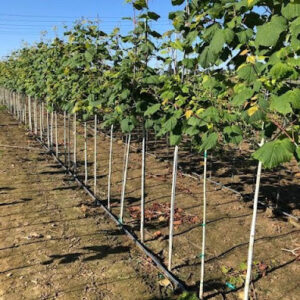Trees for Japanese Gardens
Trees are an important part of the Japanese Garden, providing beauty and serenity year round. Adding trees with four seasons of interest provides a connection to the natural rhythms of nature. The climate in Japan and the Pacific Northwest are similar, providing garden space to celebrate this landscape design.
Japanese Maples
Japanese Maples are the most popular and likely tree to be found in a Japanese Garden. Japanese gardens often plant Japanese Maples to enhance the sense of tranquility and harmony. Their small, finely dissected leaves create a captivating contrast with the garden’s other elements, such as moss, stones, and water features. The trees are often strategically positioned to provide shade and to frame focal points within the garden. The seasonal changes in their foliage symbolize the impermanence of life, a central concept in Japanese culture.
Flowering Cherry
Flowering Cherry trees are renowned for their stunning and ephemeral pink or white blossoms, marking the arrival of spring in Japan.
Over the centuries, they have become a symbol of the transient beauty of life, celebrated through the tradition of Hanami, the custom of enjoying the transient beauty of cherry blossoms. This tradition often involves picnics beneath the flowering branches.
Japanese Snowbell
The Japanese Snowbell tree (Styrax japonicus) is a delightful and elegant addition to Japanese gardens, known for its dainty, pendulous white blossoms and contribution to the overall tranquility of the garden setting.
Japanese Snowbell trees contribute a sense of harmony and contemplation to the garden, fostering a tranquil atmosphere for meditation and reflection.
Japanese Stewartia
The Japanese Stewartia tree (Stewartia pseudocamellia) is graceful and revered in Japanese gardens, cherished for its striking features and symbolic significance.
Its multi-seasonal interest, from the lush green foliage to the exquisite blooms and striking coppery exfoliating bark, makes it an exceptional choice. Placed near water features or alongside paths, it acts as a serene focal point. This tree embodies the Japanese concept of “wabi-sabi,” emphasizing the beauty of imperfection and the inevitability of change, imparting a sense of contemplation and mindfulness in the garden’s visitors.
Gingko
The Ginkgo tree (Ginkgo biloba), often called the “maidenhair tree,” is native to China and was introduced to Japan centuries ago. The Ginkgo’s distinctive fan-shaped leaves turn a vibrant golden-yellow in autumn. The ancient lineage of Ginkgo trees, dating back to prehistoric times, symbolizes endurance and longevity. In the context of Japanese garden design, Ginkgo trees serve as living symbols of nature’s timeless beauty and wisdom.
Dogwood
Japanese Dogwood trees, scientifically known as Cornus kousa, are a cherished addition to Japanese garden design. These small to medium-sized trees are admired for their elegant, four-petaled white or pink blossoms, which resemble delicate flowers, blooming in late spring. The vibrant fall foliage adds to their beauty with deep red and purple shades.
Crabapples
Crabapples have stunning spring blossoms in shades of pink and white; these trees infuse gardens with an air of purity and renewal. The delicate, fragrant flowers symbolize the fleeting nature of life, a central theme in Japanese culture. As the seasons change, the trees produce small, colorful fruit, adding autumnal interest.
Magnolia Trees
In Japanese culture, magnolia trees create spring allure in the garden. Magnolias can represent purity and the unfolding of life’s potential, embodying the core garden principles of harmony and balance.
Trees for Japanese gardens provide wonderful contrasts of color, texture, and various forms. From small container trees to larger specimen trees exceeding 100 years old, Japanese Gardens showcase the beauty of these trees.
Showing 1–9 of 17 results
-

Acer palmatum ‘Emperor 1’ – Emperor 1 Japanese Maple
-

Acer palmatum dissectum ‘Crimson Queen’ – Crimson Queen Japanese Maple
-

Acer palmatum dissectum ‘Orangeola’ – Orangeola Japanese Maple
-

Acer palmatum dissectum ‘Seiryu’ – Laceleaf Japanese Maple
-

Acer palmatum dissectum ‘Tamukeyama’ – Tamukeyama Japanese Maple
-

Acer tegmentosum ‘Joe Witt’ – Manchurian Snakebark Maple
-

Ginkgo biloba ‘Autumn Gold’ – Autumn Gold Ginkgo
-

Ginkgo biloba ‘Magyar’ – Magyar Ginkgo
-

Ginkgo biloba ‘Princeton Sentry’ – Princeton Sentry Ginkgo
